【第七十九回目】
言問団子:名物の団子を守って
Kototoi Dango: Preserving Speciality Dango
Kototoi Dango: Preserving Speciality Dango
| セインさん、今日お訪ねするのは、向島の「言問団子」です。 Thayne-san, today we’re going to visit Kototoi Dango in Mukojima. |
|
| 「言問団子」って、おもしろい名前ですね。 Kototoi Dango is an interesting name. |
|
| お店は江戸末期の創業ですが、明治に入って、平安時代の有名な歌人・在原業平(ありわらのなりひら)が隅田川のほとりに、遊ぶ白い水鳥を見て詠んだ和歌から、この名を付けたそうです。 「名にしおはば いざ言問はむ都鳥 我が思ふ人はありやなしやと」 (そういう名前の鳥ならば聞いてみよう。都鳥よ、私が恋しく思うあの人は今も京の都で元気でいるのか) 向島は風光明媚なところなので、江戸時代にはお花見や月見、雪見など、江戸っ子が散策を楽しんだり、文人墨客が歌を詠んだりして、文化が息づいてきたところです。ですから、この切ない恋歌から名づけた団子も、人々に深く愛されたんですね。 Kototoi Dango was established around 1860, at the end of the Edo Period, and it was apparently named in the Meiji Period after a poem composed by the famous Heian Era Poet Ariwara no Narihira when he saw white waterfowl frolicking by the nearby Sumida River. Na ni shiohaba, iza kototowamu miyakodori, waga omou hito wa ari ya nashi ya to (“If there is a bird by that name then I will ask, oh oystercatcher, is the one I love still well in Kyoto?”) Mukojima is a scenic area, so in the Edo Period, Edo natives enjoyed taking walks there for flower viewing, moon viewing and snow viewing and the literati composed poems. It was alive with culture. So the sweet rice dango that were named after such a heartbreaking love poem were deeply adored by the people. |
|
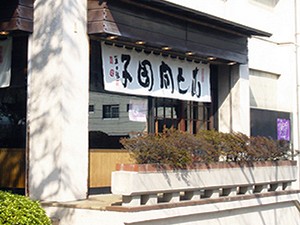 お店の写真 [A photo of the store] |
|
| (外山) | ようこそ。当主の外山和男です。 Toyama: Hello. I’m the owner, Kazuo Toyama. |
| こんにちは、外山さん。隅田川のほとり、本当に素晴らしいロケーションにお店がありますね。外山さんで何代目になるのですか? Hello. Your shop is in a really lovely location by the Sumida River. What generation of owner are you? |
|
| (外山) | 私で6代目です。言問団子は、江戸末期に大名屋敷の植木職人をしていた初代が、向島に遊ぶ文人墨客をもてなすのに手製の団子をふるまったのが始まりです。その味が評判になって、茶店・菓子処となり、現在に続いています。 「言問団子」の名がついたのは明治に入ってからですが、セインさん、隅田川に架かる「言問橋」をご存じですか? あの橋の名前は、この「言問団子」という店の名から名付けられたんですよ。 Toyama: I’m the sixth generation. The founder of Kototoi Dango was a gardener for a lord household at the end of the Edo Period, and it started when he made homemade dango for the literati who came to have fun in Mukojima. Everyone liked the taste of his dango, and and that lead to making a tea house and then a confectionary shop, and so it is to this day. The name Kototoi Dango came about in the Meiji Era. Thayne-san, do you know the Kototoi Bridge over the Sumida river? It was named after this shop. |
| へーっ! 地名からお店の名前をつける例は多いですが、その逆があるんですね。そのくらい言問団子は有名な店だったんだ。 言問団子の姿かたちは、創業当時から変わっていないんですか? Wow! There are a lot of examples of stores that get their names from places, but I guess the opposite can happen too. Kototoi Dango must have really been famous. Has Kototoi Dango changed much since the founder’s time? |
|
| (外山) | あっさりとした甘味と、串に刺さずにクロモジの楊枝で召し上がっていただくというところは変わっていません。ただ、江戸時代は小豆餡と白餡の2色で、6個で1人前としていました。そこに明治時代に、味噌餡を入れた「青梅」が加わって3色に。お店では、1人前3個を皿に盛ってお出ししています。 セインさんも、まずは作り立ての言問団子を召し上がってみてください。 Toyama: The light sweetness and the way of eating them with kuromoji wood toothpicks instead of on skewers hasn’t changed. But in the Edo Period there were two colors, azuki bean paste and white bean paste, and a single serving was six dango. Then in the Meiji Era we added green plum color with sweet miso paste inside, so there were three colors. At the store, we serve them three to a plate. Thayne-san, would you first try eating some Kototoi Dango? |
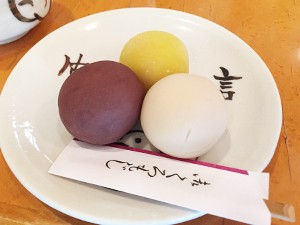 お店で供される言問団子 [The Kototoi Dango offered at the shop.] |
|
| おいしい! 3個で、多すぎず少なすぎずちょうどいいですね。 そして、食べ終わると見えてくるお皿がかわいい! Delicious! Three is the perfect number to eat. And the design that appears as you eat the dango is cute. |
|
| (外山) | 都鳥を描いた絵なんです。明治時代は三浦乾也(みうらけんや)の乾也焼。大正時代は白井善人の今戸焼。そして、現在のものは瀬戸の陶工・寺田みのるさんに焼いてもらっています。同じ作家でも、年数を経ると絵が変わってきて、それもおもしろいところですし、手書きですから1枚として同じものがないのも味わいです。 店の片隅にギャラリーも作っていますので、よろしければ昔の器もご覧になってください。 Toyama: It’s a picture of oystercatchers. In the Meiji Era, the dishes were made in Kenya-yaki style by Miura Kenya. In the Taisho Era, they were made in Imado-yaki style by Shiroi Zento. And the current ones were made for us by Terada Minoru, a Seto-style potter. Even if the dishes are made by the same artist, as they grow older their art changes, and that’s interesting too. Because they are hand painted, each one has a unique flavor. We made a gallery in the corner of the store, so please take a look at the old dishes. |
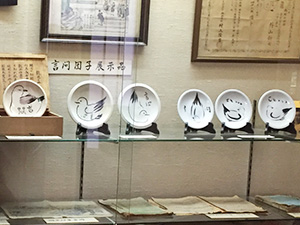 都鳥の器 [Dish with oystercatcher] |
|
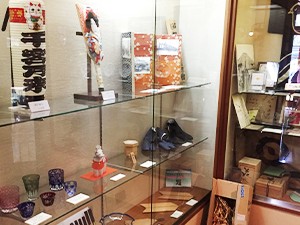 ギャラリー [Gallery] |
|
| (外山) |
暖簾も、ぜひご覧になってください。古いものは中林梧竹、現在のものは殿村藍田によるものです。 Toyama: Please have a look at the shop curtain too. The old one was by Nakabayashi Gochiku, the present one is by Tonomura Randen. |
| 迫力がある字で、この店によく似合っていますね。店内にはほかに掛け軸や錦絵なども飾られていて、いい雰囲気ですね。 ところで、この言問団子を作るのに一番大切にされていることは何ですか? The calligraphy is forceful, and it suits this store well. There are also hanging scrolls and woodblock prints inside, creating an inviting atmosphere. By the way, what is considered most important when making Kototoi Dango? |
|
| (外山) |
それは、原材料にお金を惜しまず、いいものを使う、ということに尽きます。 「小豆餡」には十勝産のふじむらさき小豆を、「白餡」には十勝産の手亡豆を、「青梅」の味噌餡は、京都の白味噌と新潟の赤味噌を合わせています。それから、一緒にお出ししているお茶の茶葉も、団子をより楽しんでいただけるよう、爽やかな香りがする上質の茶葉を仕入れています。 Toyama: We put all our efforts and spare no expense when it comes to procuring quality ingredients. The azuki beans in the azuki bean paste are Fuji-murasaki azuki from Tokachi, the beans in the white bean paste are white garden beans from Tokachi, and the sweet miso paste in the green plum dango is a mixture of white miso from Kyoto and red miso from Niigata. Also, the tea served with the dango is made with high quality tea leaves with a refreshing scent so that you can enjoy the dango even more. |
| デコレーションをしない単純なお菓子なので、原料を吟味することが、すべての始まり。それでこそ、味わいも守られるんですね。 家訓なども伝わっているんですか? They’re simple, undecorated sweets, so everything begins with selecting the ingredients. That’s how you’re able to preserve the flavor. Do you have family rules that have been passed down from previous generations? |
|
| (外山) |
3つあるんです。一つ目は、当主はここを住まいとすること。住居を別に設けず、たえず店の隅々まで目を行き届かせよ、ということです。二つ目は、暖簾分けをしないこと。そして三つ目は、団子以外のものを作ってはいけない、と。 でも、実は今、予約限定ではあるんですが「言問最中」も販売しているんです。言問団子は1日しかもたない菓子ですので、手土産向きの菓子はないかというお客様のご要望にお応えしたものです。ご先祖様には内緒で(笑)。 Toyama: There are three. The first is, the owner must live at the store. That way he can continually keep an eye on every corner of the operation. The second is he must not establish any other branches. The third is he must not to make anything other than dango. But actually, we now have a special-order Kototoi Monaka. Kototoi dango only keep for one day, so we made something for the customers who were requesting something to take home as a souvenir. Please don’t tell my ancestors (laughs). |
| たしかに、言問団子のこの味わいは、時間がたつと失われてしまう繊細なお菓子ですからね。 Kototoi dango is certainly a delicate sweet that will soon lose its unique flavor. |
|
| (外山) | はい。ですから、朝全部作って夕方までに売り切るというのではなく、できるだけ少量ずつこまめに作って、お店に来てくださるお客様には作り立てを食べていただくようにしています。つまり、1日中、同じ作業を何度も繰り返しているんです。 Yes, that’s why we try to make them in the smallest batches possible and serve our guests freshly made dango, rather than make them all in the morning and sell them all by evening. In other words, we repeat the same process over and over all day. |
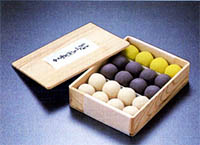 言問団子(杉箱20個入り) [Kototoi dango (Cedar box of 20)] |
|
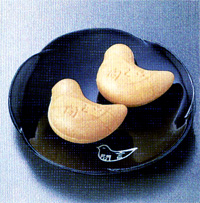 言問最中(要予約) [Kototoi Monaka (Reservation-only)] |
|
| そういうきめ細かな心配りのいる作業を、160年余も受け継いでこられたんですね! お話を聞いて、なんだか背筋が伸びる気がしました。 お菓子の味わいを守る一方で、変えようとしていることもありますか? Such careful work has been passed down for 160 years. Thinking about that kind of thing makes me sit up straight. While working to preserve the taste of your sweets, is there anything you’re trying to change? |
|
| (外山) | 当店は、店の横に隅田川に出る桟橋を持っているんですが、それをいろいろな方にも使っていただけたらと思って船宿さんにお話をしているところです。 Toyama: Next to this shop there’s a jetty reaching out into the Sumida River, so I’m talking to boat captains about getting people to use it. |
| お客様が屋形舟でここに到着されるなんて、粋ですね。 It would be very stylish to have the customers arrive in yakatabune. |
|
| (外山) | いろいろな工夫をしながら、一人でも多く方に、この団子を知っていただきたい、食べていただきたいと思っているんです。 Toyama: I want to try different ways of letting people know about dango and to enjoy them. |
| いいですね! 今日はありがとうございました。 Great! Thanks for showing us around today. |
|
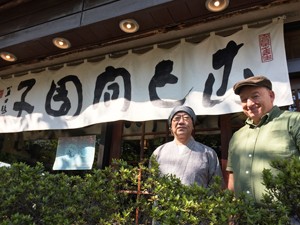
|
|
| 向島 言問団子ホームページはコチラ | |
| (文)太田美代 (英訳)デイビッド・A・セイン |
 1959年、米国生まれ。証券会社勤務を経て来日し、翻訳・通訳など多岐にわたって活躍。豊富な教授経験を生かし、数多くの英語関係書籍を執筆。近著に『日本人のチョットへんな英語』(アスコム)、『超入門シャドーイング』(主婦の友社)、日本人が使いすぎる英語(PHP文庫)など多数。 下町の魅力に魅了され、自身が代表を務める英語関連のコンテンツ会社のエートゥーゼットのオフィスを根津に構えている。英会話本の執筆をしながら、東京・文京区根津と春日にあるエートゥーゼット英語学校の校長も務める。 http://www.smartenglish.co.jp/
1959年、米国生まれ。証券会社勤務を経て来日し、翻訳・通訳など多岐にわたって活躍。豊富な教授経験を生かし、数多くの英語関係書籍を執筆。近著に『日本人のチョットへんな英語』(アスコム)、『超入門シャドーイング』(主婦の友社)、日本人が使いすぎる英語(PHP文庫)など多数。 下町の魅力に魅了され、自身が代表を務める英語関連のコンテンツ会社のエートゥーゼットのオフィスを根津に構えている。英会話本の執筆をしながら、東京・文京区根津と春日にあるエートゥーゼット英語学校の校長も務める。 http://www.smartenglish.co.jp/







